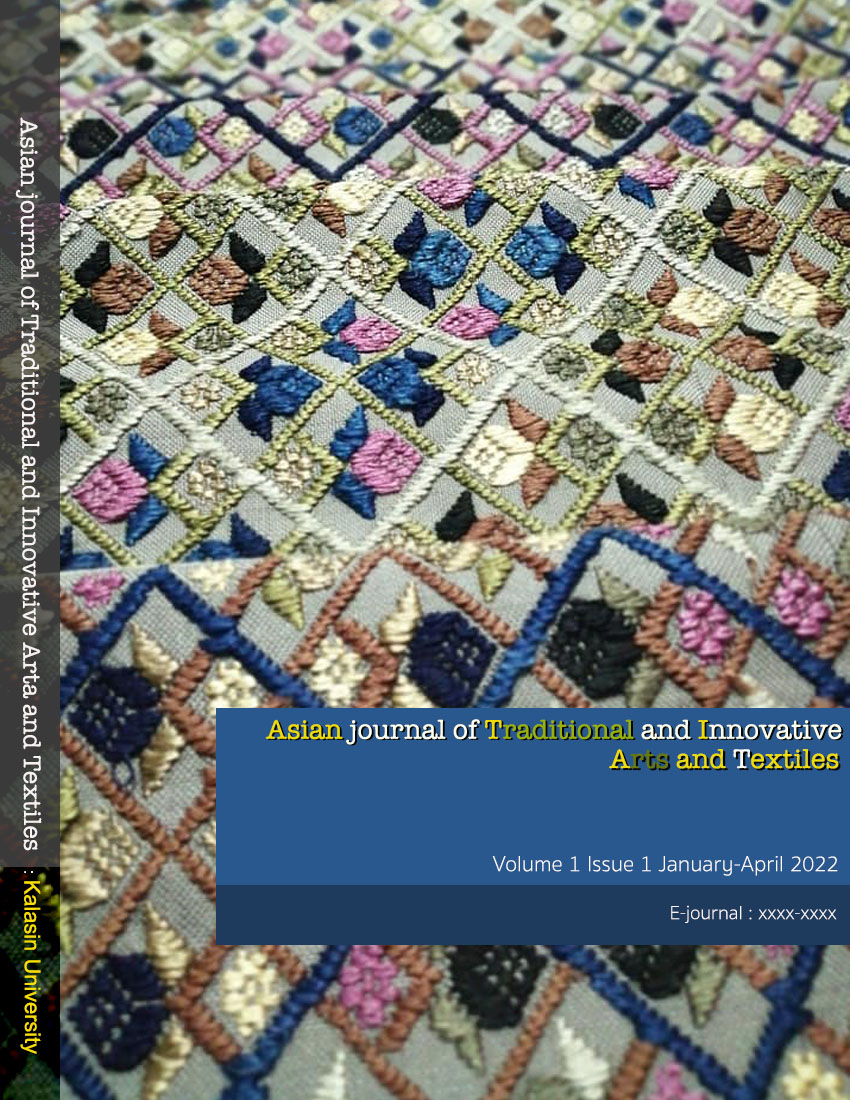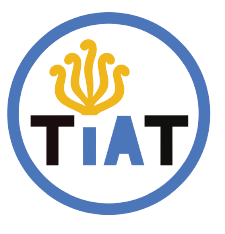Creation of “Pin Phu-Tai” from waste materials at Ban Kud Wa, Kud Wah Subdistrict, Kuchinarai District Kalasin Province
Keywords:
Pin Phu-tai , Creation , Waste materialsAbstract
An article on the creation of a Pin Phu-Tai from waste materials in Ban Kud Wa community, Kud Wa sub-district, Kuchinarai district. Kalasin Province It is a mixed research. to study the status of Thai folk music scholars Structured questionnaire type research tools were used. Determine the target group of knowledgeable people, 1 person and 2 people involved, obtained by choosing a specific and the peasant sage was obtained by snowballing and study the creation of Pin Phu-taifrom waste materials using participatory observation research tools and in-depth interviews. Determine the target group of knowledgeable people, 1 person, 1 practitioner, obtained by selective selection. and assessment tools using estimators Determine the target group as those involved in making Thai harp and compare the sound of 3 Thai harpists, obtained by specific selection.
The results of the research revealed that the status of the village philosopher In terms of the history, the village sages playing the harp were 100% male and ethnic Thai, and the respected village sages had an average age of 52.4 years or more. Started learning Thai music at the age of 14, the teachers were members of the community and In terms of musical expertise, Thai people find that the most skilled musical instrument is the harp, especially the Thai Lai Lam Phu. And in terms of transmitting Thai music, it was found that the sage continued to transmit Thai music to his students. As for the research results in creating Thai harp from waste materials. It was found that 5 harp were created with the same physical characteristics as follows: the harp neck, the harp head and the harp harp made of padauk wood. Harp knobs use guitar knobs. Fret harp made of bamboo harp strings using guitar strings The difference in physical characteristics is the part of the harp. The harp is made from a square shaped zinc tin. Square shape thinner cans round tin can A round shaped galvanized can with a wooden panel covering the back of the can. and made of bamboo with a cylindrical shape An expert assessment showed that the five creative harps from waste materials had an average value of 4.123 and an SD value of 0.464. So It shows that the creation of a harp from waste material has a high valuation that can be used for playing and can be passed on to children and youth.
References
กระทรวงการพัฒนาสังคมและความมั่นคงของมนุษย์. แผนแม่บทการพัฒนากลุ่มชาติพันธุ์ในประเทศไทย (พ.ศ.2558-2560). ค้นข้อมูลวันที่ 17 สิงหาคม 2563, จาก https://hhdc.anamai.moph.go.th/th/master-plan-for-ethnic-development-in-thailand.
กฤษฎา ดาวเรือง. (2564). การวิเคราะห์กระบวนการถ่ายทอดเพลงพิณตามภูมิปัญญาครูทองใสทับถนน. มนุษยศาสตร์สาร. 22(1), 65-85.
เคนสิงห์ รองไชย. (2542). ประวัติไทบ้านกุดหว้า(บ้านกุดหว้า). เอกสารอัดสำเนา.
เจนณัช สดไสย์. (2557). ผลิตภัณฑ์ตกแต่งบ้านจากวิธีและแนวคิดงานหัตถกรรมมาลัยไม้ไผ่ ตำบลกุดหว้า จังหวัดกาฬสินธุ์. วิทยานิพนธ์ปริญญาศิลปมหาบัณฑิต สาขาวิชาการออกแบบผลิตภัณฑ์ มหาวิทยาลัยศิลปากร.
ณัฐณรงค์ สีสัน. (2560). พวงมาลัยแห่งศรัทธากับการพัฒนาชุมชน: กรณีศึกษา พวงมาลัยไม้ไผ่ของชุมชนผู้ไทยกุดหว้า ตำบลกุดหว้า อำเภอกุฉินารายณ์ จังหวัดกาฬสินธุ์. วิทยานิพนธ์ปริญญาศิลปศาสตรมหาบัณฑิต สาขาวิชาชนบทศึกษาและการพัฒนามหาวิทยาลัยธรรมศาสตร์.
นารี ศรีกำพล. วันที่ 2 มกราคม 2564. สัมภาษณ์.
ทิพย์ธิดา ชุมชิตและบุรินทร์ เปล่งดีสกุล. (2560). ปัจจัยที่มีผลต่อการเปลี่ยนแปลงความเชื่อในพิธีกรรมการเหยาเลี้ยงผีของชาวผู้ไทย ตำบลกุดหว้า อำเภอกุฉินารายณ์ จังหวัดกาฬสินธุ์. วารสารศิลปกรรมศาสตร์ มหาวิทยาลัยขอนแก่น. 9(2), 124-148.
ประดิษฐ์ วิลาศ. (2564). การสร้างสรรค์ลายพิณจากศิลปินต้นแบบพื้นบ้านอีสาน. วารสารศิลปกรรมศาสตร์ มหาวิทยาลัยขอนแก่น. 13(1), 242-262.
ปิยาภรณ์ แสนศิลาและคณะ. (2562). พิธีกรรมเหยาของหมอเหยาในหมู่บ้านกุดหว้าตำบลกุดหว้า อำเภอกุฉินารายณ์ จังหวัดกาฬสินธุ์ พิธีเหยาในหมู่บ้านกุดหว้า. วารสารมนุษยศาสตร์และสังคมศาสตร์ มหาวิทยาลัยมหาสารคาม. 38(4), 56-64.
พิทยวัฒน์ พันธะศรี ปริยัติ นามสง่า และวุฒิสิทธิ์ จีระกมล. (2563). อัตลักษณ์ด้านดนตรีและศิลปะการแสดงชาวผู้ไทย อําเภอกุฉินารายณ์ จังหวัดกาฬสินธุ์. วารสารวิชาการ คณะมนุษยศาสตร์และสังคมศาสตร์ มหาวิทยาลัยราชภัฏนครสวรรค์. 7(1), 139-152.
เพชรมณียา ชุมชิต. (2555). การออกแบบลายผ้าจากมาลัยไม้ไผ่ สัญลักษณ์ประเพณีบุญข้าวประดับดิน บ้านกุดหว้า ตำบลกุดหว้า อำเภอกุฉินารายณ์ จังหวัดกาฬสินธุ์. วิทยานิพนธ์ปริญญาศิลปกรรมศาสตรมหาบัณฑิต สาขาวิชาวิจัยศิลปะและวัฒนธรรม บัณฑิตวิทยาลัย มหาวิทยาลัยขอนแก่น.
พงษ์สวัสดิ์ สุรพร. วันที่ 2 มกราคม 2564. สัมภาษณ์.
รัชนีกร ไวกล้า. (2562). ภูมิปัญญาท้องถิ่นและการอนุรักษ์ประเพณีการเหยาของชาวผู้ไทย. วารสารศิลปการจัดการ มหาวิทยาลัยราชภัฏวไลยอลงกรณ์ ในพระบรมราชูปถัมภ์. 3(1), 53-67.
วิชญ์ บุญรอด. (2564). เครื่องดนตรีสำหรับผู้สูงอายุตามรอยพ่อ(ในหลวงรัชกาลที่ 9) : กรณีครูพัฒนา สุขเกษม. JOURNAL OF FINE AND APPLIED ARTS, CHULALONGKORN UNIVERSITY. 8(1), 43-59.
สุเทพ ไชยขันธุ์. (2556). ความเป็นมาคนอีสาน ผู้ไทลูกแถน. กรุงเทพฯ : ตถาตา พับลิเคชั่น.
สุมิตร ปิติพัฒน์ และเสมอชัย พูลสุวรรณ. (2542). คนไทและเครือญาติ ในมณฑลไหหลำและกุ้ยโจว ประเทศสาธารณรัฐประชาชนจีน. กรุงเทพฯ : สถาบันไทยคดีศึกษา มหาวิทยาลัยธรรมศาสตร์.
อาริยา ป้องศิริ. (2563). ปัจจัยที่มีส่วนร่วมในการเสริมพลังการจัดทำแผนชุมชน กรณีศึกษากลุ่มท่องเที่ยวเชิงวัฒนธรรม ตำบลกุดหว้า อำเภอกุฉินารายณ์ จังหวัดกาฬสินธุ์. วารสารการบริหารปกครอง. 9(2), 303-324.
Vagias,W.M., (Ed.). (2006). “Likert-typescale response anchors. Clemson International Institute for Tourism & Research Development. Department of Parks. Recreation and Tourism Management : Clemson University”. Retrieved November 23 2021, from http://www.clemson.edu/centers-institutes/tourism/documents/sample-scales.pdf.
Downloads
Published
How to Cite
Issue
Section
License
Copyright (c) 2022 Asian journal of Traditional and Innovative Arts and Textiles

This work is licensed under a Creative Commons Attribution-NonCommercial-NoDerivatives 4.0 International License.





